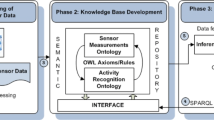Abstract
Attribute grammars are widely used by compiler-generators since it allows complete specifications of static semantics. They can also be applied to other fields of research, for instance, to human activities recognition. This paper aims to present CAPAS, a Context-aware system Architecture to monitor Physical ActivitieS. One of the components that is present in the architecture is the attribute grammar which is filled after the prediction is made according to the data gathered from the user through the sensors. According to some predefined rules, the physical activity is validated after an analysis on the attribute grammar, if it meets those requirements. Besides that it proposes an attribute grammar itself which should be able to be incorporated in a system in order to validate the performed physical activity.
Access this chapter
Tax calculation will be finalised at checkout
Purchases are for personal use only
Similar content being viewed by others
References
Knuth, D.E.: Semantics of context-free languages. Math. Syst. Theor. 2, 127–145 (1968)
Lara, O.D., Labrador, M.A.: A survey on human activity recognition using wearable sensors. IEEE Comm. Surv. Tutorials 15(3), 1192–1209 (2013)
Mukhopadhyay, S.C.: Wearable sensors for human activity monitoring: a review. IEEE Sens. J. 15(3), 1321–1330 (2015)
Capecci, M., Pepa, L., Verdini, F., Ceravolo, M.: A smartphone-based architecture to detect and quantify freezing of gait in Parkinson’s disease. Gait Posture 50, 08 (2016)
Angelo Costa, M.C., Martin, E.M., Pharos, V.J.: Physical assistant robot system. Sensors 18(8), 2633 (2018)
Xia, L., Aggarwal, J.K.: Spatio-temporal depth cuboid similarity feature for activity recognition using depth camera. In: Proceedings of the IEEE Conference on Computer Vision and Pattern Recognition, pp. 2834–2841 (2013)
Ming, Y., Ruan, Q., Hauptmann, A.G.: Activity recognition from RGB-D camera with 3D local spatio-temporal features. In: 2012 IEEE International Conference on Multimedia and Expo, pp. 344–349. IEEE (2012)
Jalal, A., Kamal, S., Kim, D.: Shape and motion features approach for activity tracking and recognition from kinect video camera. In: 2015 IEEE 29th International Conference on Advanced Information Networking and Applications Workshops, pp. 445–450. IEEE (2015)
He, Z.-Y., Jin, L.-W.: Activity recognition from acceleration data using ar model representation and SVM. In: 2008 International Conference on Machine Learning and Cybernetics, vol. 4, pp. 2245–2250. IEEE (2008)
Abowd, G.D., Dey, A.K., Brown, P.J., Davies, N., Smith, M., Steggles, P.: Towards a better understanding of context and context-awareness. In: Gellersen, H.-W. (ed.) HUC 1999. LNCS, vol. 1707, pp. 304–307. Springer, Heidelberg (1999). https://doi.org/10.1007/3-540-48157-5_29
Alegre, U., Augusto, J.C., Clark, T.: Engineering context-aware systems and applications. J. Syst. Softw. 117(C), 55–83 (2016)
Musumba, G.W., Nyongesa, H.O.N.: Context awareness in mobile computing a review. Int. J. Mach. Learn. Appl. 2(1), 5 (2016)
Schilit, B.N., Theimer, M.M.: Disseminating active map information to mobile hosts. IEEE Network 8(5), 22–32 (1994)
Freitas, L.O., Henriques, P.R., Novais, P.: Uncertainty in context-aware systems: a case study for intelligent environments. WorldCIST (2018)
Yujie, Z., Licai, W.: Some challenges for context-aware recommender systems. In: 2010 5th International Conference on Computer Science Education, August 2010, pp. 362–365 (2010)
Karol, S.: An introduction to attribute grammars. Department of Computer Science. Technische Universitat Dresden, Germany (2006)
Hassan, M.M., Uddin, M.Z., Mohamed, A., Almogren, A.: A robust human activity recognition system using smartphone sensors and deep learning. Future Gener. Comput. Syst. 81, 307–313 (2018)
Acknowledgements
“This work has been supported by FCT – Fundação para a Ciência e Tecnologia within the Project Scope: UID/CEC/00319/2019.”
Author information
Authors and Affiliations
Corresponding author
Editor information
Editors and Affiliations
Rights and permissions
Copyright information
© 2019 Springer Nature Switzerland AG
About this paper
Cite this paper
Ferreira, P., Freitas, L.O., Henriques, P.R., Novais, P., Pavón, J. (2019). CAPAS: A Context-Aware System Architecture for Physical Activities Monitoring. In: Pérez García, H., Sánchez González, L., Castejón Limas, M., Quintián Pardo, H., Corchado Rodríguez, E. (eds) Hybrid Artificial Intelligent Systems. HAIS 2019. Lecture Notes in Computer Science(), vol 11734. Springer, Cham. https://doi.org/10.1007/978-3-030-29859-3_54
Download citation
DOI: https://doi.org/10.1007/978-3-030-29859-3_54
Published:
Publisher Name: Springer, Cham
Print ISBN: 978-3-030-29858-6
Online ISBN: 978-3-030-29859-3
eBook Packages: Computer ScienceComputer Science (R0)




